Today is the fifth day of Cinefest, the 17th International Festival of German Film-Heritage. Another popular star of the German cinema of the 1930s was Dutch actor Frits van Dongen (1901-1975). The handsome, deep-voiced leading man started his film career in the Netherlands and then he became a matinee idol in Germany during the late 1930s. In 1940, he moved to the USA. Billed as Philip Dorn, he became the second Dutch Hollywood star. A freak accident caused him to retire in 1955.
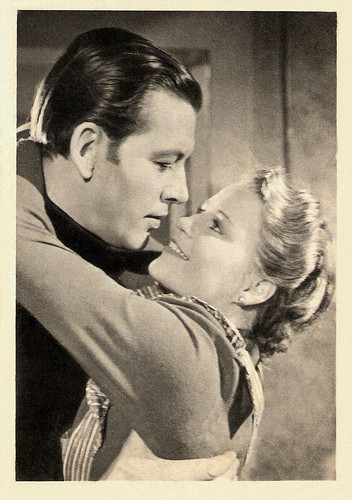
Italian postcard by Pizzi e Pizio, Milano. Photo: Majestic-Tobis / Mander S.A. Noleggio Film. Frits van Dongen and Kristina Söderbaum in Die Reise nach Tilsit/The Trip to Tilsit (Veit Harlan, 1939), released in Italy as Verso l'amore. The film was adapted from the eponymous novella (1917) by Hermann Sudermann. In the silent era, the tale was already adapted by F.W. Murnau for his film Sunrise - a Song of Two Humans (1927).
Fisherman Endrik Settegast is faring well and leads a happy life with his wife Elske and daughter, until a beautiful Polish girl, Madlyn, shows up and awakens a passionate fire in him. Initially, Endrik holds to his family and Madlyn leaves, but upon her return, he is so overcome with passion that he decides to murder his wife during a boat trip to Tilsit...

Cover of a special issue of Illustrierte Film-Bühne, no. 1466, on Die Reise nach Tilsit/The Trip to Tilsit (Veit Harlan, 1939), starring Frits van Dongen and Kristina Söderbaum. Photos: Majestic Film.

German postcard by Ross Verlag, no. A 2679/1, 1939-1940. Photo: Tobis / Quick. Probably for Die Reise nach Tilsit/The Trip to Tilsit (Veit Harlan, 1939).
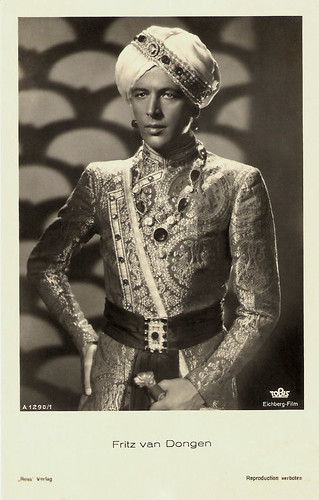
German postcard by Ross Verlag, Berlin, no. A 1290, 1937-1938. Photo: Tobis / Eichberg-Film. Publicity still for Der Tiger von Eschnapur/The Tiger of Eschnapur (1938).
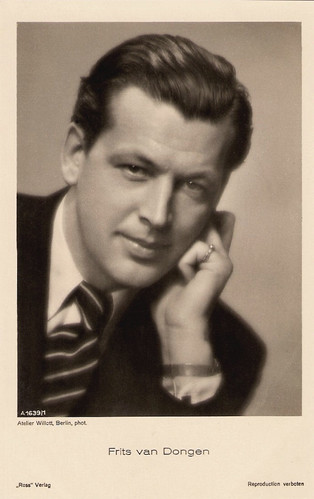
German postcard by Ross Verlag, no. A 1639/1, 1937-1938. Photo: Atelier Willott, Berlin.
Frits van Dongen was born as Hein van der Niet in Scheveningen, The Netherlands, in 1901. He was the son of shoemaker Leendert van der Niet and maid-servant Femia Schijf.
At the age of 14, Hein made his amateur stage debut. At 20, he married Cornelia Twilt whom he had met at the amateur stage company. Seven months later he became a father. He earned his money as a shoemaker but in 1923 he became a professional actor.
Under the stage name Frits van Dongen, he worked for the well-known Dutch theatre company De Haeghe-spelers from 1926 on. After a second son in 1926, his marriage did not go well. In 1929 he made a tour through the Dutch colonies. Reportedly Van Dongen had several affairs and in 1930 he and his wife divorced. A few months later, during another tour through the West Indies, he met the young actress Marianne van Dam. Two years later they married.
In 1921, he had already made his film debut as an extra in the Dutch silent film De zwarte tulp/The Black Tulip (Maurits Binger, 1921), but his film career really started with a leading part in the fisher drama Op hoop van zegen/The Good Hope (Alex Benno, Louis Saalborn, 1934). This was the third film adaptation of the most famous Dutch stage play, written by Herman Heijermans, and Van Dongen was praised for his natural acting style.
Soon more Dutch films followed. Van Dongen starred in the musical Op stap/On the Road (Ernst Winar, 1935) starring Fien de la Mar, the comedy De big van het regiment/The Regiment’s Mascot (Max Nosseck, Jan Teunissen, 1936), another comedy De Kribbebijter/The Grumbler (Hermann Kosterlitz a.k.a. Henry Koster, Ernst Winar, 1935) and the tempestuous tropical romance Rubber (Gerard Rutten, Johan de Meester, 1936) with Enny Meunier.
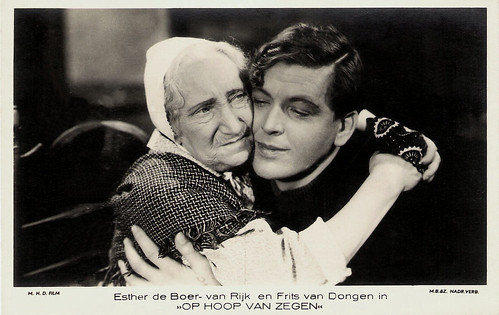
Dutch postcard by M.B. & Z. / M.H.D. Film. Photo: Dick van Maarseveen, Den Haag. Esther de Boer-van Rijk and Frits van Dongen in Op hoop van zegen/The Good Hope (Alex Benno, 1934).

Dutch postcard by M.B. & Z. (M. Bonnist & Zonen, Amsterdam). Photo: Dick van Maarseveen, Den Haag / Nationaal Film. Frits van Dongen and Fien de la Mar in Op stap/On the Move (Ernst Winar, 1935).

Dutch postcard by N.V. Monopole Film. Photo: Dick van Maarseveen. Still for De Big van het Regiment/The Darling of the Regiment (Max Nosseck, 1935) with Cruys Voorbergh, Piet te Nuyl, Matthieu van Eysden, Hansje Andriesen, Frits van Dongen, Adolphe Engers, Johan Kaart, Jan C. de Vos jr. and Jan van Ees. Collection: Geoffrey Donaldson Institute.

Dutch vintage postcard by N.V. Monopole Film. Photo: Dick van Maarseveen. Frits van Dongen, Cruys Voorbergh, Hansje Andriesen and Piet te Nuyl in De Big van het Regiment/The Darling of the Regiment (Max Nosseck, 1935). Collection: Geoffrey Donaldson Institute.

Dutch postcard by M.B. & Z. Photo: Holfi Film / Petrus Verheijen. Dolly Mollinger and Frits van Dongen in De Kribbebijter/The Cross-Patch (Hermann Kosterlitz, 1935).
In 1936 the German film studio Tobis offered Frits van Dongen a contract. He travelled to Berlin. In Berlin, he appeared in Immer wenn ich glücklich bin/Waltz Melodies (Karl Lamac, 1936) with Márta Eggerth.
The famous director Richard Eichberg gave him the leading part of Maharaja Chandra in the monumental two-part adventure Der Tiger von Eschnapur/The Tiger of Eschnapur - Das Indische Grabmal/The Indian Tomb (Richard Eichberg, 1938). This exotic extravaganza would be his breakthrough.
The suddenly popular matinee idol appeared next in the mystery melodrama Verwehte Spuren/Covered Tracks (Veit Harlan, 1938) with Kristina Söderbaum, and Der Hampelmann/The Jumping Jack (Karl Heinz Martin, 1938) with Hilde Krahl.
He also starred with Kristina Söderbaum in the psychological drama Die Reise nach Tilsit/The Trip to Tilsit (Veit Harlan, 1939), based on the novel by Hermann Sudermann, which was already filmed in a silent version as Sunrise (1927) by F.W. Murnau.
Van Dongen was now top of the bill in Berlin, but he disliked the Nazi regime so much that he decided to leave Germany.
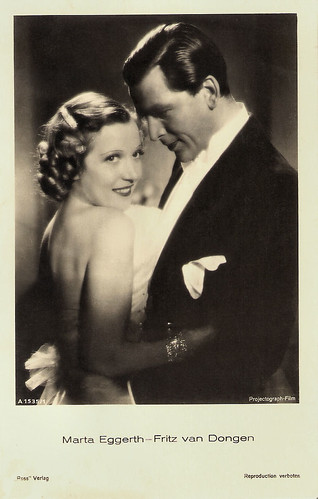
German postcard by Ross Verlag, no. A 1535/1, 1937-1938. Photo: Projectograph-Film. Marta Eggerth and Frits van Dongen in Immer wenn ich glücklich bin..!/Waltz Melodies (Karel Lamac, 1938).
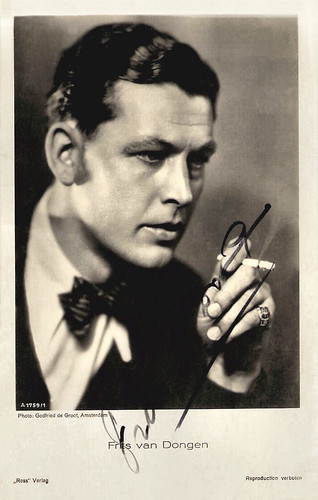
German postcard by Ross Verlag, no. A 1759/1, 1937-1938. Photo: Godfried de Groot, Amsterdam.

German postcard by Ross Verlag, no. A 1982/1, 1937-1938. Photo: Haenchen / Tobis.

German postcard by Ross Verlag, no. A 1982/2, 1937-1938. Photo: Haenchen / Tobis.
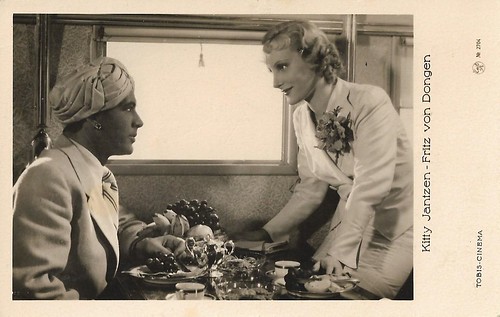
Latvian postcard by E&B, Riga, no. 2704. Photo: Tobis-Cinema. Frits van Dongen and Kitty Jantzen in Das indische Grabmal/The Indian Tomb (Richard Eichberg, 1938).

German postcard by the journal Das Programm von Heute, with permission of Ross Verlag. Photo: Tobis. Publicity still for Der Tiger von Eschnapur/The Tiger of Eschnapur (1938).
In 1939, Frits van Dongen moved to America just before World War II broke out. Director Henry Koster had invited him to come to Hollywood and gave him introductions. Between 1940 and 1951 he acted in dozens of MGM productions under the name Philip Dorn. He started with the low-budget anti-Nazi film Enemy Agent (Lew Landers, 1940). During the war years, 10 of his 15 films were also propaganda films.
He was usually cast as Continental lovers, anti-Nazi Germans or refugees. His notable films include Escape (Mervyn LeRoy, 1940) starring Norma Shearer and Robert Taylor, Ziegfeld Girl (Robert Z. Leonard, 1941) with Judy Garland, and Underground (Vincent Sherman, 1941).
Dorn also appeared in Tarzan's Secret Treasure (Richard Thorpe, 1941) starring Johnny Weissmuller, Random Harvest (Mervyn LeRoy, 1942) with Greer Garson, the melodrama Reunion in France (Jules Dassin, 1942) opposite Joan Crawford, Blonde Fever (Richard Whorf, 1944) with Gloria Grahame, and Passage to Marseille (Michael Curtiz, 1944) with Humphrey Bogart.
In between films, he did tours for the army with the Freedoms War Bond Show. Having long suffered from phlebitis, he had the first of a series of strokes in 1945. Over the next few years, he went on to have a heart attack and required brain surgery.
He couldn’t work for a period, but in 1947 he appeared on Broadway in 'The Big Two' at the side of Claire Trevor. He began playing more mature film roles in the late 1940s, notably as a tyrannical symphony conductor in I've Always Loved You (Frank Borzage, 1946) and as Papa in I Remember Mama (George Stevens, 1948) with Irene Dunne as Mama.

Belgian postcard, editor unknown. Photo: Metro-Goldwyn-Mayer.

French postcard by Editions P.I., Paris, no. 231. Photo: Metro Goldwyn Mayer.
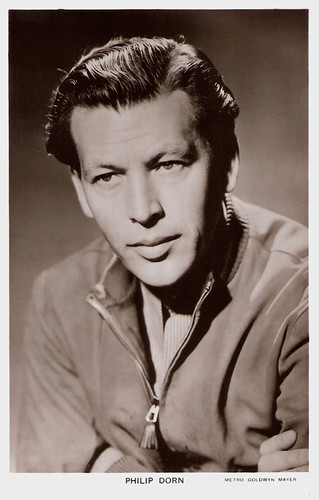
British postcard by Picturegoer Series, no. W 63. Photo: Metro Goldwyn Mayer (MGM).

Belgian postcard, no. 3036. Photo: RKO Radio Films.

Belgian postcard. Photo: Republic Pictures. Frits van Dongen in I've Always Loved You (Frank Borzage, 1946).
When his MGM contract ended in 1952, Frits van Dongen returned to Europe and acted in German films like the drama Hinter Klostermauern/The Unholy Intruders (Harald Reinl, 1952) with Olga Tschechova, the romance Der Träumende Mund/Dreaming Lips (Josef von Baky, 1953) starring Maria Schell, and the circus romance Salto Mortale (Victor Tourjansky, 1953).
He did not succeed in making a really successful come-back in Germany, and in 1954-1955, he appeared opposite former Dutch film star Lily Bouwmeester on the Dutch stages in the comedy play 'Het Hemelbed'(The Four-poster) by Jan de Hartog.
When he was visiting his birth town Scheveningen in 1955, he was the victim of a freak accident. While he walked along a building site, a plank fell on his head. A brain injury eventually ruined his speaking ability, and Van Dongen had to retire.
He lived the last two decades of his life confined to his comfortable California home. Frits van Dongen died of a heart attack in Los Angeles, USA, in 1975. He was 73. Van Dongen was still married to Marianne van Dam. He had divorced his Jewish wife in 1937 but they remarried in 1939 and would stay together in California till his death.
In 2002 a biography was published in the Netherlands: 'Nederlands eerste Hollywood-ster, Hein van der Niet alias Frits van Dongen alias Philip Dorn' (The First Dutch Hollywood Star, Hein van der Niet aka Frits van Dongen aka Philip Dorn), by Hans Toonen.

German autograph card by Gevaert.

German postcard by Kunst und Bild, Berlin, no. A 664. Photo: Allegro / Herzog-Film / Bayer. Frits van Dongen in Türme des Schweigens/Towers of silence (Hans Bertram, 1952).

German postcard by VEB Volkskunstverlag Reichenbach, no. G 711. Photo: Komet-Film. Publicity still for Salto mortale (Viktor Tourjansky, 1953).

German postcard by Kolibri Verlag, no. 746. Photo: Komet / Panorama / Ewald. Frits van Dongen in Salto mortale (Viktor Tourjansky, 1953), Van Dongen's last film.

German postcard by F.J. Rüdel Postkarten-Verlag, Hamburg-Bergedorf. Photo: Venus / Delta / National.
Sources: Hal Erickson (AllMovie), Thomas Staedeli (Cyranos), Henk van Gelder (Biografisch Woordenboek van Nederland - Dutch), Mariska Graveland (De Filmkrant - now defunct), Wikipedia and IMDb.
This post was last updated on 17 January 2024.

Italian postcard by Pizzi e Pizio, Milano. Photo: Majestic-Tobis / Mander S.A. Noleggio Film. Frits van Dongen and Kristina Söderbaum in Die Reise nach Tilsit/The Trip to Tilsit (Veit Harlan, 1939), released in Italy as Verso l'amore. The film was adapted from the eponymous novella (1917) by Hermann Sudermann. In the silent era, the tale was already adapted by F.W. Murnau for his film Sunrise - a Song of Two Humans (1927).
Fisherman Endrik Settegast is faring well and leads a happy life with his wife Elske and daughter, until a beautiful Polish girl, Madlyn, shows up and awakens a passionate fire in him. Initially, Endrik holds to his family and Madlyn leaves, but upon her return, he is so overcome with passion that he decides to murder his wife during a boat trip to Tilsit...

Cover of a special issue of Illustrierte Film-Bühne, no. 1466, on Die Reise nach Tilsit/The Trip to Tilsit (Veit Harlan, 1939), starring Frits van Dongen and Kristina Söderbaum. Photos: Majestic Film.

German postcard by Ross Verlag, no. A 2679/1, 1939-1940. Photo: Tobis / Quick. Probably for Die Reise nach Tilsit/The Trip to Tilsit (Veit Harlan, 1939).

German postcard by Ross Verlag, Berlin, no. A 1290, 1937-1938. Photo: Tobis / Eichberg-Film. Publicity still for Der Tiger von Eschnapur/The Tiger of Eschnapur (1938).

German postcard by Ross Verlag, no. A 1639/1, 1937-1938. Photo: Atelier Willott, Berlin.
Tempestuous tropical romance
Frits van Dongen was born as Hein van der Niet in Scheveningen, The Netherlands, in 1901. He was the son of shoemaker Leendert van der Niet and maid-servant Femia Schijf.
At the age of 14, Hein made his amateur stage debut. At 20, he married Cornelia Twilt whom he had met at the amateur stage company. Seven months later he became a father. He earned his money as a shoemaker but in 1923 he became a professional actor.
Under the stage name Frits van Dongen, he worked for the well-known Dutch theatre company De Haeghe-spelers from 1926 on. After a second son in 1926, his marriage did not go well. In 1929 he made a tour through the Dutch colonies. Reportedly Van Dongen had several affairs and in 1930 he and his wife divorced. A few months later, during another tour through the West Indies, he met the young actress Marianne van Dam. Two years later they married.
In 1921, he had already made his film debut as an extra in the Dutch silent film De zwarte tulp/The Black Tulip (Maurits Binger, 1921), but his film career really started with a leading part in the fisher drama Op hoop van zegen/The Good Hope (Alex Benno, Louis Saalborn, 1934). This was the third film adaptation of the most famous Dutch stage play, written by Herman Heijermans, and Van Dongen was praised for his natural acting style.
Soon more Dutch films followed. Van Dongen starred in the musical Op stap/On the Road (Ernst Winar, 1935) starring Fien de la Mar, the comedy De big van het regiment/The Regiment’s Mascot (Max Nosseck, Jan Teunissen, 1936), another comedy De Kribbebijter/The Grumbler (Hermann Kosterlitz a.k.a. Henry Koster, Ernst Winar, 1935) and the tempestuous tropical romance Rubber (Gerard Rutten, Johan de Meester, 1936) with Enny Meunier.

Dutch postcard by M.B. & Z. / M.H.D. Film. Photo: Dick van Maarseveen, Den Haag. Esther de Boer-van Rijk and Frits van Dongen in Op hoop van zegen/The Good Hope (Alex Benno, 1934).

Dutch postcard by M.B. & Z. (M. Bonnist & Zonen, Amsterdam). Photo: Dick van Maarseveen, Den Haag / Nationaal Film. Frits van Dongen and Fien de la Mar in Op stap/On the Move (Ernst Winar, 1935).

Dutch postcard by N.V. Monopole Film. Photo: Dick van Maarseveen. Still for De Big van het Regiment/The Darling of the Regiment (Max Nosseck, 1935) with Cruys Voorbergh, Piet te Nuyl, Matthieu van Eysden, Hansje Andriesen, Frits van Dongen, Adolphe Engers, Johan Kaart, Jan C. de Vos jr. and Jan van Ees. Collection: Geoffrey Donaldson Institute.

Dutch vintage postcard by N.V. Monopole Film. Photo: Dick van Maarseveen. Frits van Dongen, Cruys Voorbergh, Hansje Andriesen and Piet te Nuyl in De Big van het Regiment/The Darling of the Regiment (Max Nosseck, 1935). Collection: Geoffrey Donaldson Institute.

Dutch postcard by M.B. & Z. Photo: Holfi Film / Petrus Verheijen. Dolly Mollinger and Frits van Dongen in De Kribbebijter/The Cross-Patch (Hermann Kosterlitz, 1935).
Exotic extravaganza
In 1936 the German film studio Tobis offered Frits van Dongen a contract. He travelled to Berlin. In Berlin, he appeared in Immer wenn ich glücklich bin/Waltz Melodies (Karl Lamac, 1936) with Márta Eggerth.
The famous director Richard Eichberg gave him the leading part of Maharaja Chandra in the monumental two-part adventure Der Tiger von Eschnapur/The Tiger of Eschnapur - Das Indische Grabmal/The Indian Tomb (Richard Eichberg, 1938). This exotic extravaganza would be his breakthrough.
The suddenly popular matinee idol appeared next in the mystery melodrama Verwehte Spuren/Covered Tracks (Veit Harlan, 1938) with Kristina Söderbaum, and Der Hampelmann/The Jumping Jack (Karl Heinz Martin, 1938) with Hilde Krahl.
He also starred with Kristina Söderbaum in the psychological drama Die Reise nach Tilsit/The Trip to Tilsit (Veit Harlan, 1939), based on the novel by Hermann Sudermann, which was already filmed in a silent version as Sunrise (1927) by F.W. Murnau.
Van Dongen was now top of the bill in Berlin, but he disliked the Nazi regime so much that he decided to leave Germany.

German postcard by Ross Verlag, no. A 1535/1, 1937-1938. Photo: Projectograph-Film. Marta Eggerth and Frits van Dongen in Immer wenn ich glücklich bin..!/Waltz Melodies (Karel Lamac, 1938).

German postcard by Ross Verlag, no. A 1759/1, 1937-1938. Photo: Godfried de Groot, Amsterdam.

German postcard by Ross Verlag, no. A 1982/1, 1937-1938. Photo: Haenchen / Tobis.

German postcard by Ross Verlag, no. A 1982/2, 1937-1938. Photo: Haenchen / Tobis.

Latvian postcard by E&B, Riga, no. 2704. Photo: Tobis-Cinema. Frits van Dongen and Kitty Jantzen in Das indische Grabmal/The Indian Tomb (Richard Eichberg, 1938).

German postcard by the journal Das Programm von Heute, with permission of Ross Verlag. Photo: Tobis. Publicity still for Der Tiger von Eschnapur/The Tiger of Eschnapur (1938).
Continental lovers, Anti-Nazi Germans or refugees
In 1939, Frits van Dongen moved to America just before World War II broke out. Director Henry Koster had invited him to come to Hollywood and gave him introductions. Between 1940 and 1951 he acted in dozens of MGM productions under the name Philip Dorn. He started with the low-budget anti-Nazi film Enemy Agent (Lew Landers, 1940). During the war years, 10 of his 15 films were also propaganda films.
He was usually cast as Continental lovers, anti-Nazi Germans or refugees. His notable films include Escape (Mervyn LeRoy, 1940) starring Norma Shearer and Robert Taylor, Ziegfeld Girl (Robert Z. Leonard, 1941) with Judy Garland, and Underground (Vincent Sherman, 1941).
Dorn also appeared in Tarzan's Secret Treasure (Richard Thorpe, 1941) starring Johnny Weissmuller, Random Harvest (Mervyn LeRoy, 1942) with Greer Garson, the melodrama Reunion in France (Jules Dassin, 1942) opposite Joan Crawford, Blonde Fever (Richard Whorf, 1944) with Gloria Grahame, and Passage to Marseille (Michael Curtiz, 1944) with Humphrey Bogart.
In between films, he did tours for the army with the Freedoms War Bond Show. Having long suffered from phlebitis, he had the first of a series of strokes in 1945. Over the next few years, he went on to have a heart attack and required brain surgery.
He couldn’t work for a period, but in 1947 he appeared on Broadway in 'The Big Two' at the side of Claire Trevor. He began playing more mature film roles in the late 1940s, notably as a tyrannical symphony conductor in I've Always Loved You (Frank Borzage, 1946) and as Papa in I Remember Mama (George Stevens, 1948) with Irene Dunne as Mama.

Belgian postcard, editor unknown. Photo: Metro-Goldwyn-Mayer.

French postcard by Editions P.I., Paris, no. 231. Photo: Metro Goldwyn Mayer.

British postcard by Picturegoer Series, no. W 63. Photo: Metro Goldwyn Mayer (MGM).

Belgian postcard, no. 3036. Photo: RKO Radio Films.

Belgian postcard. Photo: Republic Pictures. Frits van Dongen in I've Always Loved You (Frank Borzage, 1946).
Salto mortale
When his MGM contract ended in 1952, Frits van Dongen returned to Europe and acted in German films like the drama Hinter Klostermauern/The Unholy Intruders (Harald Reinl, 1952) with Olga Tschechova, the romance Der Träumende Mund/Dreaming Lips (Josef von Baky, 1953) starring Maria Schell, and the circus romance Salto Mortale (Victor Tourjansky, 1953).
He did not succeed in making a really successful come-back in Germany, and in 1954-1955, he appeared opposite former Dutch film star Lily Bouwmeester on the Dutch stages in the comedy play 'Het Hemelbed'(The Four-poster) by Jan de Hartog.
When he was visiting his birth town Scheveningen in 1955, he was the victim of a freak accident. While he walked along a building site, a plank fell on his head. A brain injury eventually ruined his speaking ability, and Van Dongen had to retire.
He lived the last two decades of his life confined to his comfortable California home. Frits van Dongen died of a heart attack in Los Angeles, USA, in 1975. He was 73. Van Dongen was still married to Marianne van Dam. He had divorced his Jewish wife in 1937 but they remarried in 1939 and would stay together in California till his death.
In 2002 a biography was published in the Netherlands: 'Nederlands eerste Hollywood-ster, Hein van der Niet alias Frits van Dongen alias Philip Dorn' (The First Dutch Hollywood Star, Hein van der Niet aka Frits van Dongen aka Philip Dorn), by Hans Toonen.

German autograph card by Gevaert.

German postcard by Kunst und Bild, Berlin, no. A 664. Photo: Allegro / Herzog-Film / Bayer. Frits van Dongen in Türme des Schweigens/Towers of silence (Hans Bertram, 1952).

German postcard by VEB Volkskunstverlag Reichenbach, no. G 711. Photo: Komet-Film. Publicity still for Salto mortale (Viktor Tourjansky, 1953).

German postcard by Kolibri Verlag, no. 746. Photo: Komet / Panorama / Ewald. Frits van Dongen in Salto mortale (Viktor Tourjansky, 1953), Van Dongen's last film.

German postcard by F.J. Rüdel Postkarten-Verlag, Hamburg-Bergedorf. Photo: Venus / Delta / National.
Sources: Hal Erickson (AllMovie), Thomas Staedeli (Cyranos), Henk van Gelder (Biografisch Woordenboek van Nederland - Dutch), Mariska Graveland (De Filmkrant - now defunct), Wikipedia and IMDb.
This post was last updated on 17 January 2024.
No comments:
Post a Comment